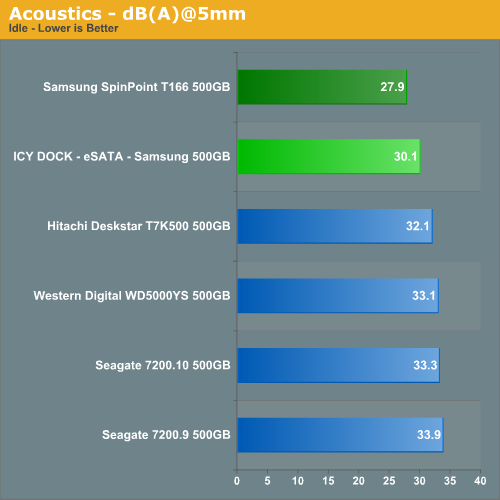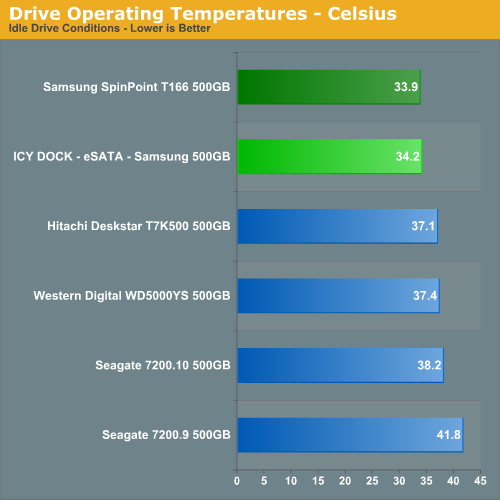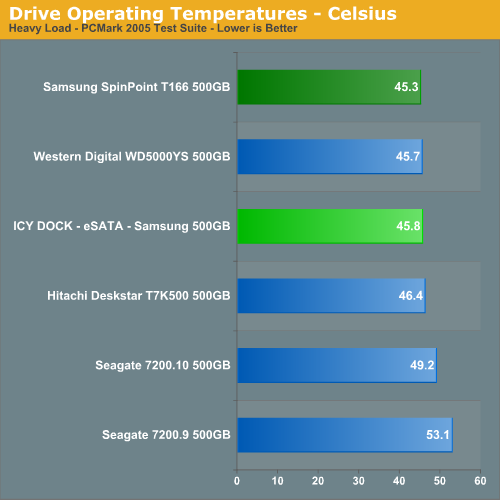ICY DOCK MB559US-1SMB: eSATA Enclosure with Pizzazz
by Gary Key and Dave Robinet on July 11, 2007 12:00 AM EST- Posted in
- Storage
Acoustics
Our acoustic test utilizes our standard test bed components but we implement Intel's power saving technology and turn off the case fans to isolate as much case noise as possible during testing. Our Corsair power supply is nearly silent in these tests and our MSI 8800GTX video card is water cooled by an external unit to provide a further decrease in our case's ambient noise levels. Our drives are attached to the drive cage with rubber bushings to assist in isolating the noise of the drive and avoid the resulting harmonic changes due to the case design.
Our acoustic tests are designed to measure the decibel levels while the system is at idle and also under load while running the General Hard Disk Drive Usage benchmark within PCMark 2005. We found through trial and error that this particular benchmark produces controlled readings across a wide range of applications within the benchmark. This particular benchmark utilizes 60% reads and 40% writes within the trace playback file.
The measurements are taken at a distance of 5mm from the rear and front of the drive being tested in order to minimize surrounding environmental noise. We have noticed that unless we run a completely silent system in a quiet room that measurements taken from 1m are generally not meaningful due to ambient noise levels. There are exceptions to this rule, but overall most modern desktop drives are quieter now than the other components in the system while under load.
The reported measurements are based on an A-weighted decibel score that measures frequencies similar to the way the human ear responds to sound. We take a total of three measurements for each test. We then subtract the high and low scores and arrive at our findings by reporting the remaining score.


Our Samsung SpinPoint T166 is already an extremely quiet drive at idle and it comes close to remaining that way in the ICY DOCK enclosure. However, since the Icy Dock is not equipped with an internal damping system or acoustic padding, it was naturally louder inside the enclosure. The external drive enclosure basically amplified any drive noise that was already present although subjectively it was difficult to discern any real differences.
Although our measurable test differences were substantial, it was quite difficult to pinpoint the differences in sound from a subjective viewpoint. Maybe all those years of hard rock have ruined our ears but in essence we found the sound emanating from the enclosure to be hollow at idle and heavy seeks having the same effect as your mother whispering loudly at you in church to wake up. It was a booming yet very soft noise that we noticed during the load tests that emphasized seek operations.
Our number one problem is the fact that our Samsung SpinPoint T166 500GB test drive likes to vibrate, in fact it would cause our test case to hum without rubber mounting grommets. The same held true for our Icy Dock enclosure, especially when mounted horizontally, but the vibration induced hum was greatly reduced with the unit in a vertical position. A small amount of vibration noise was still noticeable in this position but was less than than a bare drive mount in our test case. Our base dB(A) level in the room at the time of testing was 25 dB(A).
Thermals
Our thermal tests utilize sensor readings via the S.M.A.R.T. (Self-Monitoring, Analysis and Reporting Technology) capability of the drives and are reported by utilizing the Active SMART 2.42 utility. We also utilize thermal sensors and infrared measurement devices to verify our utility results. We test our drives in an enclosed case environment without the fans operational to simulate temperatures that could conceivably be reached in a near silent SFF or HTPC case design. We typically find the reported numbers drop anywhere from 18% to 25% on average with the case fans operational. Our base temperature level in the room at the time of testing was 25C.


Our Samsung drive basically remained at the same temperature as in our test case indicating that at least with this particular cool running drive that the case is not a hindrance to temperatures. In fact, the enclosure unit only consumes 2W of power at idle or under load which helps to contribute to the low thermal output increases we noticed during testing. We will have full results with additional drives like the WD Raptor and Hitachi 1TB drives in the roundup.
Our acoustic test utilizes our standard test bed components but we implement Intel's power saving technology and turn off the case fans to isolate as much case noise as possible during testing. Our Corsair power supply is nearly silent in these tests and our MSI 8800GTX video card is water cooled by an external unit to provide a further decrease in our case's ambient noise levels. Our drives are attached to the drive cage with rubber bushings to assist in isolating the noise of the drive and avoid the resulting harmonic changes due to the case design.
Our acoustic tests are designed to measure the decibel levels while the system is at idle and also under load while running the General Hard Disk Drive Usage benchmark within PCMark 2005. We found through trial and error that this particular benchmark produces controlled readings across a wide range of applications within the benchmark. This particular benchmark utilizes 60% reads and 40% writes within the trace playback file.
The measurements are taken at a distance of 5mm from the rear and front of the drive being tested in order to minimize surrounding environmental noise. We have noticed that unless we run a completely silent system in a quiet room that measurements taken from 1m are generally not meaningful due to ambient noise levels. There are exceptions to this rule, but overall most modern desktop drives are quieter now than the other components in the system while under load.
The reported measurements are based on an A-weighted decibel score that measures frequencies similar to the way the human ear responds to sound. We take a total of three measurements for each test. We then subtract the high and low scores and arrive at our findings by reporting the remaining score.


Our Samsung SpinPoint T166 is already an extremely quiet drive at idle and it comes close to remaining that way in the ICY DOCK enclosure. However, since the Icy Dock is not equipped with an internal damping system or acoustic padding, it was naturally louder inside the enclosure. The external drive enclosure basically amplified any drive noise that was already present although subjectively it was difficult to discern any real differences.
Although our measurable test differences were substantial, it was quite difficult to pinpoint the differences in sound from a subjective viewpoint. Maybe all those years of hard rock have ruined our ears but in essence we found the sound emanating from the enclosure to be hollow at idle and heavy seeks having the same effect as your mother whispering loudly at you in church to wake up. It was a booming yet very soft noise that we noticed during the load tests that emphasized seek operations.
Our number one problem is the fact that our Samsung SpinPoint T166 500GB test drive likes to vibrate, in fact it would cause our test case to hum without rubber mounting grommets. The same held true for our Icy Dock enclosure, especially when mounted horizontally, but the vibration induced hum was greatly reduced with the unit in a vertical position. A small amount of vibration noise was still noticeable in this position but was less than than a bare drive mount in our test case. Our base dB(A) level in the room at the time of testing was 25 dB(A).
Thermals
Our thermal tests utilize sensor readings via the S.M.A.R.T. (Self-Monitoring, Analysis and Reporting Technology) capability of the drives and are reported by utilizing the Active SMART 2.42 utility. We also utilize thermal sensors and infrared measurement devices to verify our utility results. We test our drives in an enclosed case environment without the fans operational to simulate temperatures that could conceivably be reached in a near silent SFF or HTPC case design. We typically find the reported numbers drop anywhere from 18% to 25% on average with the case fans operational. Our base temperature level in the room at the time of testing was 25C.


Our Samsung drive basically remained at the same temperature as in our test case indicating that at least with this particular cool running drive that the case is not a hindrance to temperatures. In fact, the enclosure unit only consumes 2W of power at idle or under load which helps to contribute to the low thermal output increases we noticed during testing. We will have full results with additional drives like the WD Raptor and Hitachi 1TB drives in the roundup.










13 Comments
View All Comments
sheh - Friday, July 13, 2007 - link
What would be more interesting is an enclosure that includes a 1000 or even just 100Mbit LAN, in addition to USB (and possibly eSATA). It'd be invaluable being able to hook to older computers at faster than (theoretic) 12Mbit and to be accessible to multiple computers on the network.paulwatsonjr - Friday, July 13, 2007 - link
On the chart you show that esata is not daisy chain'able (which is true.) However, I thought I remembered seeing something about esata now having some sort of multi-port capability, similar to daisy chaining, that is supported by the latest round of Intel chipsets...Farfle - Thursday, July 12, 2007 - link
There are a ton of these eSata enclosures out there, and all seem to advertise to do the same thing. They probably all do, for the most part at least. I purchased this model from Beyond Micro:http://www.newegg.com/Product/Product.aspx?Item=N8...">http://www.newegg.com/Product/Product.aspx?Item=N8...
The main reasons I chose this over other competitors was the following:
1. On/Off power switch on the front (although, admittedly, kinda useless--not to mention risky--if you're using it as you're system drive, hehe..."Ooops, there goes Windows!")
2. The AC adapter's power plugin is one of those rounded inner/outer types that makes connecting to the enclosure a snap! I always hate trying to allign those S-Video-type power plug-ins to their mates (like on this Icy Dock model).
3. Built-in fan. Some HDs get quite hot, and it's nice to have a fan to keep 'em cool. Also, it appears the top of the Beyond Micro drive has an aluminum cover, which better conducts the heat.
Some bad things about it tho, is installation was kind of unnecesarily complicated. It comes with screws that you need to ensure you utilize, otherwise the cooling effects are minimized, and the noise becomes more apparent.
I'm not trying to "comment" crap here, but just sharing my experience with this particular product type.
*Note - One other thing to think about--that applies to all these eSata enclosures--is the PCI bracket. I bought this drive for use in a Baby-atx Low Profile case (one of those computers that can sit under your monitor...like the good ol' PC days). Unfortunately, none of these enclosures come with a Low-profile bracket. I had to purchase this special one from Addonics for $7 + $7 shipping:
http://www.addonics.com/shopaddonics/default.asp?i...">http://www.addonics.com/shopaddonics/default.asp?i...
$14 dollars for a stupid little metal bracket is a bit absurd, but I had no other choice (if I wanted to keep the setup pretty). So, unless you have an onboard eSata connection and you're using a low profile computer, you're kinda stuck having to purchase this extra peripheral.
Googer - Wednesday, July 11, 2007 - link
How would performance have been differant had a Western Digital Raptor been used instead of a 7200 RPM Samsung over USB? Could you post some benchmarks?Dave Robinet - Wednesday, July 11, 2007 - link
I wouldn't expect the Raptor to come out significantly better, to be honest. The transfer rate of either drive saturates the bus, though I'd imagine the Raptor would improve things slightly in heavy small file access times (certain games, etc). As I mentioned, though, it likely wouldn't be much - looking at the Load Level Time benchmark in the 2nd last page would be a best case scenario, IMO.Gary's a pretty busy man these days, so I'm not sure I'd count on the benchmarks for the Raptor in the USB this time around. Sorry. :)
lennylim - Wednesday, July 11, 2007 - link
Good to find a review of this unit. Now that I started searching around, I see that there are a number of other reviews on it, but I don't check those sites as often as Anandtech.I first saw something similar at a local B&M. It seems to be sold under a few brand names, like Cremax and SohoTank. What sets it apart from others is a hot swappable, removable tray. While you could buy a 250-300GB HDD for the base unit, each additional HDD tray would only set you back $20 or so. If you use external drives for backups, this seems like a better solution than getting individual enclosures for every drive. Advantage : less clutter. Disadvantage : cannot use more than one unit at a time (unless you get more base units, of course).
I really like the idea of an external enclosure with a hot swap tray, but would prefer one that is dampened (less noise / vibration, important when the drive is closer to you) and has active cooling (i.e. a fan). And icing on the cake would be to have USB and firewire ports on it as well. Best bet right now seems be to build one using a mini ITX enclosure. Not having an extra power brick (and an on/off switch that cuts power to the power supply, not just the enclosure) will also be nice.
The short summary about eSATA (how AHCI is necessary for hot swap, etc.) is also useful - something I've been wondering about for a while. Can anyone point to sites with additional info on eSATA, specifically how to add it to an older system without eSATA so that it supports hot swap, any drives that don't play well with hot swap? TIA.
Dave Robinet - Wednesday, July 11, 2007 - link
Thanks for the comments.The simplest way to add eSATA to existing systems is with the use of a controller card (as people often do with SCSI). Which OS are you using?
lennylim - Wednesday, July 11, 2007 - link
Mainly XP (Pro and Home) and Linux, though support for Linux now mainly falls under the "nice to have".strikeback03 - Thursday, July 12, 2007 - link
My P965 board has eSATA through one of the JMicron controllers, support for this has been in the Linux kernels since 2.6.18. so eSATA works fine in my system (2.6.20 kernel), though it might depend more on support for the controller chip than eSATA in general.ninjit - Wednesday, July 11, 2007 - link
Quick question about burst speed.You showed that the enclosure had a much lower Burst speed than when the drive was mounted internally, which you attributed to ICY DOCK's controller only supporting the SATA 150 spec at the moment.
However I just looked at their website for more details, and they specificially mention SATA 300 speed support, and have their own HDTACH results to back it up.
http://www.icydock.com/MB559US-1S_SPEED_TEST.pdf">http://www.icydock.com/MB559US-1S_SPEED_TEST.pdf
Could it be a setting or cable issue that caused your tests to drop down to 150?